Running Shoes Information and Resources from the AAPSM (original) (raw)
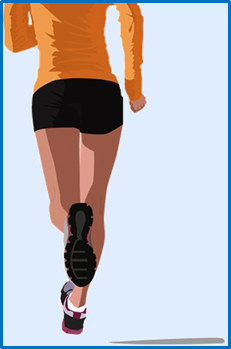
Footwear - Running Shoes
A Sports Medicine Podiatrist knows how important the proper shoe can be for a patient, especially runners and walkers! Historically, people looked purely at your foot type alone to determine what type of shoe you should be in; however, as new technologies emerge, evolve, and new study data comes out, we see that deciding the best shoe for a specific person is more complicated then that! While foot type is important, it is just one factor of many that needs to be considered. So instead of recommending specific shoes and brands, the AAPSM advises that individuals become familiar with the structural features that work well for them, seek out those features when replacing shoes, and seek the advice of an AAPSM Podiatrist to help point you in the correct direction.
Some running publication websites and footwear retailing sites review and award running shoes. The majority of websites offering reviews and awards have a financial relationship with the footwear industry, so it is important to recognize this bias when reading those publications.
The first step to determining the best type of shoe for an individual is understanding basic shoe anatomy. It is important to understand the qualities that make up a running shoe and their purpose so that we can make the best recommendations.
Running Shoe Anatomy
Knowing the components and their purpose is key to help you better understand running shoes.
A shoe is Broken down into 3 main sections: the Upper, the Midsole, and the Outsole.
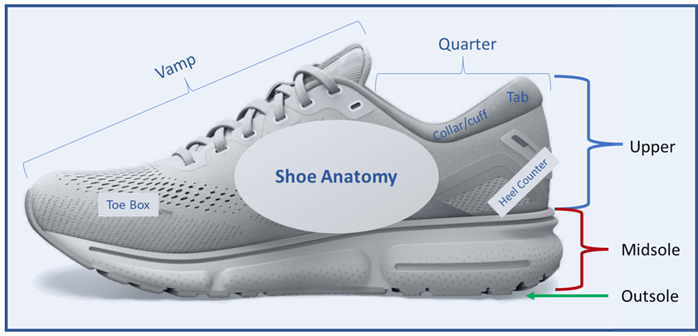
The Upper:
As the name suggests this makes up the material on the top part of the shoe, which is made up of the following parts:
- The Vamp: the part of the upper that goes from the toe box to the quarter. It overs the top and middle part of the foot. This will be a lightweight flexible and breathable material, most of these are a woven knit or a mesh.
- The Tongue: Of course, the tongue protects the foot from lace pressure. Tongues can either be free (meaning that they are only connected at the distal edge) or gusseted.
- A Gusseted tongue: is stitched in place on all 3 sides or connected to the midsole by a flexible fabric. The purpose of a gusseted tongue is to protect the foot from dirt and debris entering the shoe. This is something you will find in many trail running shoes, hiking boots, snow boots, and work boots.
- The Laces:
- Eyelets: the holes the laces go through
- Aglet: the plastic/metal on the end of the shoelaces
- The Quarter: refers to the rear and sides of the upper that covers the heel.
- Heel Tab: extra padding to protect the Achilles
- Heel collar/Heel Cuff: extra pads and cushions to help protect the malleoli
- The Heel Counter: a firmer material, like a stiffer plastic, either externally or as an insert to reinforce and
support the heel. Can improve the stability of the heel and rotational control in the rearfoot.- This is the main reason why it is important to counsel your patients to untie their shoes before they take them on and off. Stepping and pushing into tied shoes will damage the integrity of the heel counter.
- The size and firmness of the heel counter can vary. In stability and motion control shoes the heel counter is going to be stiffer and larger as this can improve rearfoot stability. In more minimalist shoes, the heel counter will still be present however may be thinner, smaller, and less firm.

Outsole:
The outsole is commonly referred to as the tread pattern of the shoe. The treads, used for traction, will vary based on what type of surface the shoe is designed for.
- A road running shoe will have small, low profile, uniform, shallow, lightweight, and flexible treads.
- Trail running shoes, like snow tires, will have deeper treads for better traction. The out sole pattern is one of the big differences between Road and Trail running shoes. Trail running shoes are further broken down to light versus technical trail.
- Light Trail shoes, for harder packed trails, will have deep treads, but they also will still be more lightweight and flexible.
- Technical trail shoe are for softer muddier trails, so the treads are going much deeper, thicker, and firmer.
Last:
The last is the form that the shoe was made on. There are 3 main types of lasts.
- Curved last: When looking at the footprint of the shoe there will be lazy C-shaped curve bisecting the heel curving toward the great toe. Common in lightweight and less supportive shoes such as racing flats
- Straight last: They are heavier but more stable with the bisection of the heel and the forefoot forming a straight line. This is found in motion control and orthopedic stability style shoes.
- Semi-curved last: A hybrid between the two. The majority of running shoes on the market are semi-curved.
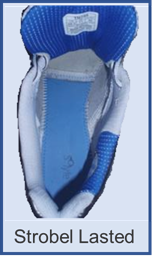
Another important piece of terminology in relation to the last is how the last is attached to the shoe.
- Slip lasting: the upper of the shoe is glued or stitched directly to the midsole which allows the shoe to be lighter and more flexible. You can recognize a slip lasted shoe by removing the insole and looking for a seam down the middle of the footbed.
- Board lasting: the upper is attached to a board which is then placed on top of the midsole. This is used in more stability type shoes but the tradeoff is that it is heavier and stiffer.
- Combination lasting: uses a board last method in the heel and a slip last method in the forefoot which allows for a stable heel and a more flexible toe.
- Strobel Lasting: A thin sheet of material such as EVA is glued to the midsole then the upper is stitched to the material. You can recognize a strobel lasted shoe by the stitching around the perimeter of the footbed. Strobel lasted shoes are less flexible than slip lasted yet not as rigid or heavy as board lasted shoes.
Toe Box:
This is the front of the shoe where your toes are. It is important to note that the width of the toe box frequently does not correlate with the width of the shoe. The difference in last size in a wide vs. regular width shoes is the in volume of the middle part of the foot, NOT the front of the foot. Not all wide width shoes have a wide toe box. When looking for a wider toe box shoe it is important to look for specific brands and models as this is more of a design feature and not a product of the shoe width. Patients with bunions, tailor’s bunions, and interspace neuromas can benefit from a wider toe box.
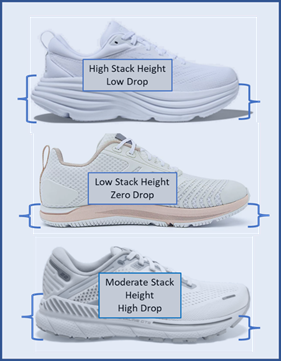
Midsole:
The midsole is sandwiched between the upper and the outsole. This midsole is the most important part of the shoe in terms of cushioning and stability. This is the part of the shoe that has seen the most change, advancement, and controversy in the past decade. This is also where we will start seeing more differences of opinion as to which type of midsole is considered best and where the current hot button topics in footwear design are.
The midsole material is typically a shock absorbing material such as a polyurethane or EVA foam. Brands then also add their additional elements such as air or gel. There are two very important pieces of terminology when describing the midsole: the stack height and the offset (AKA drop). These terms are related but not the same and it is important to know the difference.
- Sack height: refers to the amount of shoe material between your foot and the ground essentially how thick the midsole it is.
- Low Stack height: will have a more natural ground feel with less cushioning
- High stack height means that there is a larger amount of material for a more cushioned feel and greater shock absorption.
- Offset/Drop: the height difference of the midsole between the rearfoot and the forefoot (heel and toe)
- Low offset is between 0-6 mm
- High offset is typically 7-12 mm
- Meaning that the heel height is 7-12 mm higher than the height of the ball of the foot.
- A high stack height shoe can have a low offset (a maximalist shoes) which is why it is important not to confuse these terms.
- Midsole Stiffness: This is how much flexibility there is to bend between the heel and the toe. Traditional stability shoes, motion control shoes, and maximalist shoes will tend to be stiffer. In comparison a minimalist shoe will tend to be much more flexible.
- There is a current trend in marathon race shoes to be extremely stiff. A maximalist shoe with a carbon fiber plate in the midsole was used to run the first sub-2-hour marathon. It is important to discuss with your patients that this type of stiff carbon fiber plated marathon running shoe is designed for elite runners to improve their running economy during a long race and they are not designed for everybody as a daily training shoe.
- Forefoot rocker: An upward rotation of the midsole and outsole of shoe. This helps transition the foot quicker to the push off phase of gait and helps propel the body forward. Almost all running shoes will have a slight rocker and the degree can vary quite a bit between brands and models. The rocker can start at the level of the toes, MPJs, metatarsal midshaft, or more proximal to encompass the entire forefoot. The more proximal the rocker starts the more help the shoe offers to help propel motion forward. Shoes with a higher degree of a forefoot rocker can benefit those patients with significant hallux limits and other forefoot pathology.
Arch Support in Shoe Design:
There are several ways that arch support can be built into the running shoe design.
- Straight and/or border lasting: As described above
- Medial Posting: higher density material around the inside of the shoe in the region of the midfoot/arch in the midsole. Utilized to help prevent excess pronation. Historically this is one of the key components that defined a "stability" shoe. Stability shoes can be broken down into mild-moderate-high stability based on the volume and size of the higher density medial midsole post.
- J-Frame or Guide Rails: This can be an alternative to a medial post or in conjunction with a medial post. This is a thinner higher density material insert in the midsole that wraps around the lateral heel and extends through the medial longitudinal arch. This higher density material does not encompass the full thickness of the midsole like the medial post does. Rather than push the foot out of pronation this technology tries to stabilize the foot in a neutral position, preventing rotation.
- Shank: Arch support can also be achieved by adding a rigid shank. The shank is a supportive structure toward the bottom of the shoe, integrated between the midsole and the outsole that runs through the area underneath the arch. A more rigid shank ensures that the shoe will not flex under the arch which offers more stiffness and support through the midfoot.
Types of Shoes:
After reviewing the basics of shoe anatomy here is a breakdown of the various general basic categories of shoes on the market. Please note there are other types that do not fit into these exact categories, this a review of the most common and basic terminology.
- Minimalist Shoes: Light weight, low stack height, low drop, with a more natural feel. This type of shoe lends towards the forefoot to midfoot strike. Very similar to a lightweight racing flat.
- Barefoot shoes: Basically, a minimal minimalist shoe. It will have very little to no midsole, very lightweight, a zero drop, and outsole flexibility. Marketed to a subset of forefoot strikers.
- Maximalist Shoe: High stack height, firmer sole, low drop, forefoot rocker, with a light weight but cushioned bouncy feel. This type of shoe can potentially benefit all foot strike patterns and is popular with patients with forefoot pathology and those who need more shock absorption. They can be divided into neutral and stability models.
- Traditional shoe: A moderate stack height and high offset shoe. These shoes are further broken down into neutral, stability, and motion control. As mentioned in the beginning, shoes used to be solely recommended based on arch shape/foot type, but we are learning it is much more complex than that. Below are the traditional types of shoes and what they were historically recommended for:
- Neutral shoe: does not have any additional arch support features built into the shoes. Traditionally recommended for a neutral foot type or mild over supinator
- Neutral Cushioned Shoe: a neutral shoe with additional shock absorbing and cushioning material, such as more air or more gel incorporated into midsole. For those runners needing more shock absorption and traditionally recommended for over supinators.
- Stability Shoe: Further broken down to mild-moderate-high stability based on the components used to add additional pronatory support to the shoe. Traditionally for mild to moderate overpronators.
- Motion Control Shoe: Will have all the features that add support and stability together, a straight last, board lasting, rigid shank, and higher density extensive medial posting that wraps around to the lateral rearfoot. This type of shoe will be significantly more stable but also much heavier. Patients with severe over pronation, obesity, or instability in the rearfoot would traditionally be recommended this type of shoe.
- In the Question of “what type of shoe is best?” there is no one shoe or brand that is the best for everybody. The true answer to that question is, “the best type of shoe is the shoe with the best combination of factors for that specific individual.” Some claim that one type of shoe causes more injures than others, BUT if you look at the emerging research you will see that it isn’t that one type of shoe will cause more injuries than others...It is that each type of shoe can make you more prone to different injury patterns.
How to Make the Best Shoe Recommendations and How to know what the Best Type of Shoe for you is:
As it has become evident while discussing the various aspects of shoe anatomy, there are many factors that go into shoe selection. Unfortunately, there is not a one size fits all approach and the best way to make shoe suggestions is to individualize the recommendation to the specific person. According to the biomechanics research, humans do not respond in a systematic way to footwear features and since gait patterns are highly unique, it is not always possible to predict how someone will interact with a given shoe and sometimes there can be a process of trial an error as well. Historically and traditionally, we used solely foot type to determine what shoe a patient should be in, but it is more complicated than that. Please visit your local AAPSM Podiatrist to help you make your decision!
The important factors to consider when making shoe recommendation are:
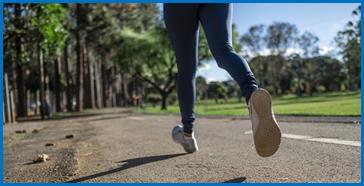
- A person’s individual needs
- Running surface
- Foot strike pattern
- Foot and arch type
- Hip, knee, leg position/rotation
- Injury and pain history
- Body Mass Index (BMI)
- Experience level
- Training distance/intensity
- Race/performance expectations